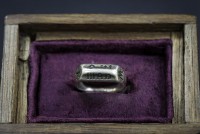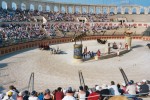 The ring purported to have belonged to Joan of Arc that was sold at auction last month for $412,845 is back in France. Its new home is the Puy du Fou theme park in the Vendée region of western France where the ring was unveiled with great pomp on Sunday by the park founder Philippe de Villiers before a crowd of 5,000.
The ring purported to have belonged to Joan of Arc that was sold at auction last month for $412,845 is back in France. Its new home is the Puy du Fou theme park in the Vendée region of western France where the ring was unveiled with great pomp on Sunday by the park founder Philippe de Villiers before a crowd of 5,000.
The theme of Puy du Fou is French history through the centuries. Visitors can enjoy gladiatorial combat and real live quadriga races at the Gallo-Roman stadium, the traditional crafts in the medieval city, the adventures of the Knights of the Round Table complete with dragon slaying and enchanted lake, a Viking longship attack on a wooden keep, a working mill and musicians in the 18th century village, the bird of prey show in a ruined castle, a joust and tricks from horseback knights, the vicissitudes of a French naval officer fresh from the Revolutionary War in America to the French Revolution, a swashbuckling 17th century adventure of the dastardly Richelieu versus the King’s Musketeers, a Belle Epoque city ca. 1900, a fire fountain show on the lake at night and much more.
 This party-time version of the past is a fitting setting for the ring because there are widespread doubts as to its authenticity. An Oxford University laboratory dated the ring to the 15th century based on its style, wear and engraving, but that’s as close as it gets to any actual facts linking this jewelry to the Maid of Orléans. They share a century. That’s all we know for sure. The long track record of ownership history included with the ring is entirely speculative. It’s based solely on the fact that Lady Ottoline Morrell’s ancestry can be traced back to Cardinal Henry Beaufort, Bishop of Winchester, who was present at the trial and execution of Joan of Arc. There are no references in archives or histories that mention the ring being owned by anyone in the family at any time between 1431 and when it first appears on the historical record in 1914.
This party-time version of the past is a fitting setting for the ring because there are widespread doubts as to its authenticity. An Oxford University laboratory dated the ring to the 15th century based on its style, wear and engraving, but that’s as close as it gets to any actual facts linking this jewelry to the Maid of Orléans. They share a century. That’s all we know for sure. The long track record of ownership history included with the ring is entirely speculative. It’s based solely on the fact that Lady Ottoline Morrell’s ancestry can be traced back to Cardinal Henry Beaufort, Bishop of Winchester, who was present at the trial and execution of Joan of Arc. There are no references in archives or histories that mention the ring being owned by anyone in the family at any time between 1431 and when it first appears on the historical record in 1914.
On the advice of experts, neither the town of Orléans nor the Joan of Arc Historical Exhibition in Rouen bid for the ring. There are many fake Joan of Arc relics out there, and the association of this particular piece with Joan only dates to the early 20th century when there was a revival of Joanmania. Philippe de Villiers is no museum curator, however, and he insists despite the lack of evidence that the ring is unquestionably authentic. As a politician, leader of the conservative Movement for France party, he is keen to claim Joan and there’s a hefty portion of nationalism underpinning this acquisition. At Sunday’s unveiling he said “It’s a little bit of France that has returned. The ring has come back to France and will stay here,” then launched into a stirring rendition of La Marseillaise.
 He was putting Britain on notice there. Appropriately enough, the export of the ring has sparked a war, of words this time, between the British and French. When the auctioneers gave the ring to park lawyers, they informed them that an export license would have to be secured before the ring could leave the country. Any antiquity worth more than £39,219 that has been in the UK for more than 50 years requires a special export license issued by the Culture Minister. The license is only issued after the Reviewing Committee on the Export of Works of Art and Objects of Cultural Interest (RCEWA) gives the Minister its recommendation, and in the case of this ring, it’s highly unlikely that they would have let it walk away without temporarily blocking export to give British institutions the chance to raise the purchase price and keep it in the country.
He was putting Britain on notice there. Appropriately enough, the export of the ring has sparked a war, of words this time, between the British and French. When the auctioneers gave the ring to park lawyers, they informed them that an export license would have to be secured before the ring could leave the country. Any antiquity worth more than £39,219 that has been in the UK for more than 50 years requires a special export license issued by the Culture Minister. The license is only issued after the Reviewing Committee on the Export of Works of Art and Objects of Cultural Interest (RCEWA) gives the Minister its recommendation, and in the case of this ring, it’s highly unlikely that they would have let it walk away without temporarily blocking export to give British institutions the chance to raise the purchase price and keep it in the country.
Philippe de Villiers has no intention of returning the ring, illegally exported or no, a position he made very clear at Sunday’s ceremony.
“The British government has sent our lawyer an unprecedented demand: the return of the ring to London,” Mr de Villers told the shocked throng. […] “Is the ring part of England’s national heritage?,” he asked the crowd, which booed loudly. Cheers erupted, however, when he asked whether it was part of France’s heritage.
Mr De Villiers claimed that he had checked the rules and found they only apply if the object is taken out of the European Union. In a mocking nod to Britain’s upcoming referendum over whether to remain or leave the EU, he told the crowd: “It is not at all our intention to have a Puy de Fou exit.”
In a final flourish, he laid down the gauntlet by stating: “Ladies and gentlemen from Britain, if you want to see the ring, then come to the Puy de Fou. For the rest it’s too late.” “The ring has returned to France and here it will stay…even if the European Commission orders it back.”
So much ado about a very questionable artifact. I have to admit, though, as theme parks go, even with its inherently inaccurate, sanitized, kid-friendly, way too clean version of history, it’s pretty cool. I am all over that quadriga race.